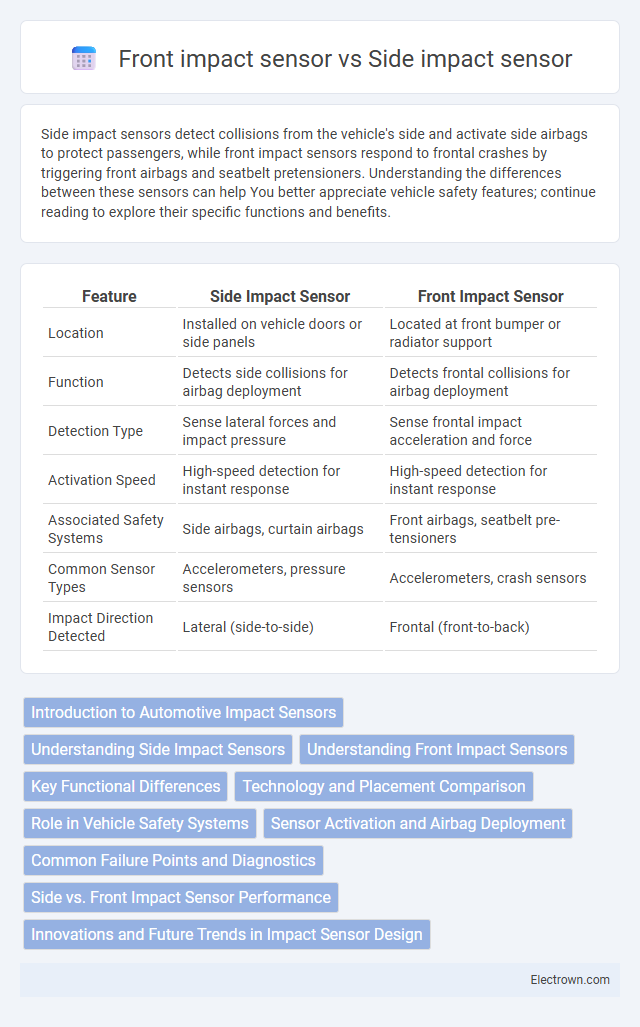Side impact sensors detect collisions from the vehicle's side and activate side airbags to protect passengers, while front impact sensors respond to frontal crashes by triggering front airbags and seatbelt pretensioners. Understanding the differences between these sensors can help You better appreciate vehicle safety features; continue reading to explore their specific functions and benefits.
Table of Comparison
| Feature | Side Impact Sensor | Front Impact Sensor |
|---|---|---|
| Location | Installed on vehicle doors or side panels | Located at front bumper or radiator support |
| Function | Detects side collisions for airbag deployment | Detects frontal collisions for airbag deployment |
| Detection Type | Sense lateral forces and impact pressure | Sense frontal impact acceleration and force |
| Activation Speed | High-speed detection for instant response | High-speed detection for instant response |
| Associated Safety Systems | Side airbags, curtain airbags | Front airbags, seatbelt pre-tensioners |
| Common Sensor Types | Accelerometers, pressure sensors | Accelerometers, crash sensors |
| Impact Direction Detected | Lateral (side-to-side) | Frontal (front-to-back) |
Introduction to Automotive Impact Sensors
Automotive impact sensors are crucial safety components designed to detect collisions and deploy airbags promptly. Side impact sensors specifically monitor lateral forces during side collisions, providing rapid response to protect passengers from intrusions. Front impact sensors focus on frontal crashes by sensing acceleration changes and triggering airbag systems to reduce injury during head-on impacts.
Understanding Side Impact Sensors
Side impact sensors detect collisions from the vehicle's sides, crucial for activating side airbags and preventing severe injuries during side crashes. These sensors use accelerometers and pressure sensors to accurately measure lateral forces and rapidly trigger safety systems. Compared to front impact sensors, which monitor frontal collisions, side impact sensors specifically enhance occupant protection in scenarios with limited crumple zones and higher side intrusion risks.
Understanding Front Impact Sensors
Front impact sensors are crucial components in vehicle safety systems designed to detect collisions at the vehicle's front end. These sensors trigger the deployment of airbags and activate other safety mechanisms to protect occupants during frontal crashes. Understanding front impact sensors helps optimize your vehicle's safety performance by ensuring timely response in critical crash scenarios.
Key Functional Differences
Side impact sensors are designed to detect lateral collisions by monitoring rapid changes in acceleration specific to the vehicle's sides, enabling timely deployment of side airbags. Front impact sensors are calibrated to sense frontal deceleration forces and trigger front airbags to protect occupants during head-on crashes. The key functional difference lies in their placement and sensitivity tailored to detect impacts from different directions, ensuring precise activation of appropriate restraint systems.
Technology and Placement Comparison
Side impact sensors utilize advanced accelerometers and pressure sensors positioned within vehicle doors and side panels to detect lateral collisions, offering rapid side intrusion detection. Front impact sensors, often radar-based or piezoelectric, are mounted in the front bumper or grille area to measure frontal crash forces and initiate airbag deployment instantly. Both sensor types integrate with the vehicle's safety control system but differ in technology and placement to optimize detection accuracy based on collision direction.
Role in Vehicle Safety Systems
Side impact sensors detect lateral collisions and activate side airbags and safety restraints to protect occupants from severe injuries. Front impact sensors measure frontal collisions, triggering airbags and seatbelt pretensioners to minimize trauma during head-on crashes. Both sensors integrate with the vehicle's electronic safety system to optimize occupant protection and reduce injury risk in different crash scenarios.
Sensor Activation and Airbag Deployment
Side impact sensors activate upon detecting lateral collisions, rapidly sending signals to deploy side airbags designed to protect occupants from intrusions and minimize injuries. Front impact sensors respond to frontal collisions by triggering driver and passenger airbags within milliseconds, cushioning the upper body and head during impact. Both sensor types utilize accelerometers and pressure sensors calibrated to specific thresholds to ensure timely airbag deployment tailored to the collision angle and severity.
Common Failure Points and Diagnostics
Side impact sensors often fail due to wiring issues or corrosion from exposure to moisture, impacting their ability to detect lateral collisions accurately. Front impact sensors commonly encounter failures in the sensor module or due to electrical faults, leading to delayed or false crash signal detection. Diagnosing your vehicle requires a computer scan of airbag system codes and physical inspection of sensor connections to ensure proper functionality.
Side vs. Front Impact Sensor Performance
Side impact sensors are specifically designed to detect lateral collisions and deploy side airbags rapidly to protect occupants from direct hits, while front impact sensors are optimized to detect frontal crashes and trigger front airbags and seatbelt pretensioners. The performance of side impact sensors depends on rapid response times due to closer proximity to occupants and variable intrusion angles, whereas front impact sensors benefit from more predictable crash dynamics and longer activation windows. Advances in sensor technology and integration with vehicle safety systems have improved detection accuracy and deployment speed for both types, enhancing overall occupant protection.
Innovations and Future Trends in Impact Sensor Design
Side impact sensors are evolving with advancements in multi-axis detection and faster signal processing to enhance occupant protection during lateral collisions. Front impact sensors are integrating AI-driven algorithms and adaptive sensitivity to accurately predict crash severity and optimize airbag deployment in real-time. Future trends emphasize sensor fusion technology and miniaturization to improve reliability and integration within vehicle safety systems.
Side impact sensor vs Front impact sensor Infographic

 electrown.com
electrown.com